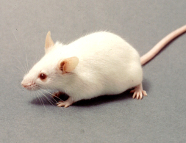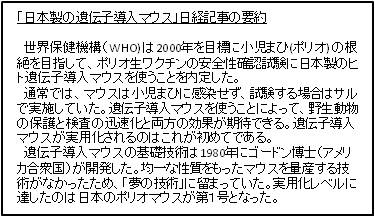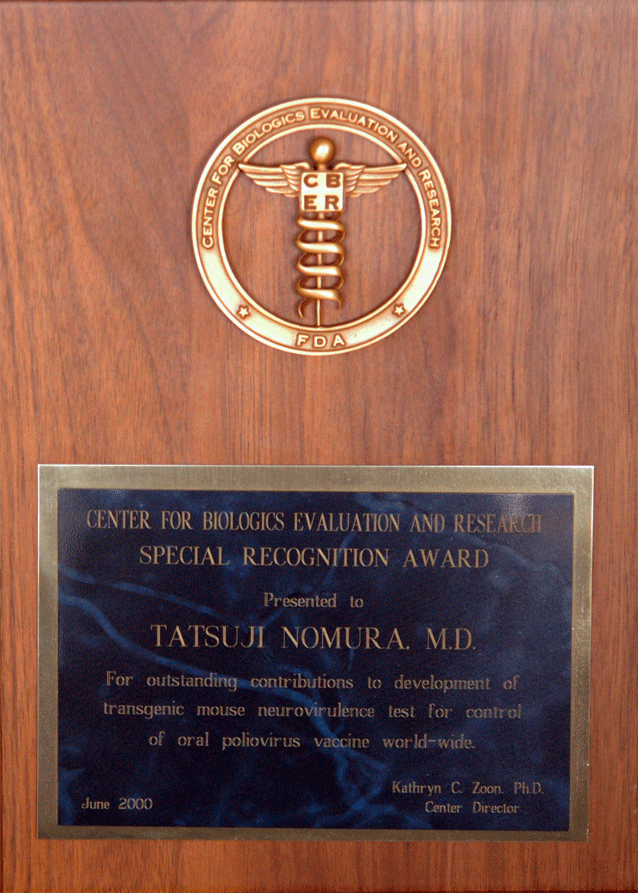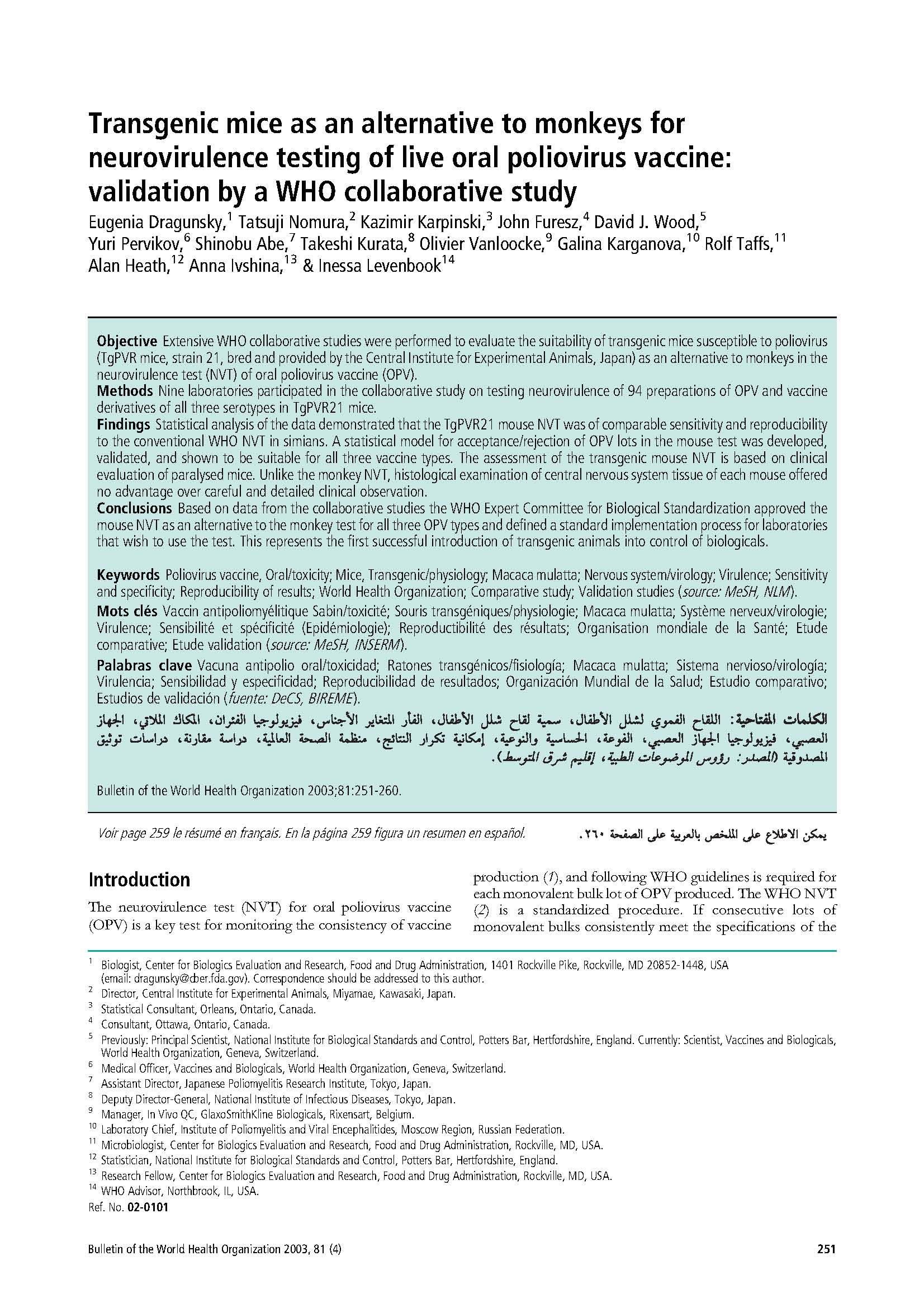Polio mouse

|
| Formal name |
IQI.Cg-Tg(PVR)21/Jic |
| Common name |
TgPVR21/IQI Jic |
| Abbreviated name |
TgPVR21
TgPVR
|
TgPVR mice for neurovirulence testing of polio live vaccines (accredited by WHO)
The in vivo assay system developed by CIEM is used for the neurovirulence testing of polio live vaccines used around the world.
Previously, monkeys had been used in the safety testing of manufactured polio live vaccines, but sometimes wrong test results were obtained with monkeys because of the large inter-individual variability.
In addition, from the viewpoint of animal welfare and resources, monkeys can no longer be used.
Therefore, CIEM developed a highly precise neurovirulence test system for polio live vaccines using genetically modified TgPVR mice created by Dr. Akio Nomoto and his team.
As this test system has been demonstrated by polio research institutions and polio live vaccine manufacturers around the world to show higher precision as compared to the testing method using monkeys, it is now officially accredited by WHO and used for safety assessment as an alternative to monkeys.
The test system of TgPVR mice is the world's first test system established and accredited as a safety evaluation system for pharmaceuticals using genetically modified animals.
Polio eradication program
Nihon Keizai Shimbun Summary article February 3, 1993
Special Recognition Award, Center for Biologics Evaluation and Research, FDA, U.S.A. (practical development of TgPVR21 mice), 2000
appreciation letter from WHO Nov.
4th, 2000
Bulletin of the WHO, 81(4), 251-260, 2003
References
-
Transgenic mice as an alternative to monkeys for neurobirulence testing of live oral poliovirus vaccine: validation by a WHO collaborative study
Dragunsky E, Karpinski K, Furesz J, Wood DJ, Pervikov Y, Abe S, Kurata T, Vanloocke O, Karganova G, Taffs R, Heath A, Ivshina A, Levenbook I.
Bulletin of the WHO, 81(4), 251-260, 2003 May 16.
-
TgPVR21 mice for testing type-3 oral poliovirus vaccines: role of clinical observation and histological examination
Dragunsky E, Chernokhvostova Y, Taffs R, Chumakov K, Gardner D, Asher D, Nomura T, Hioki K, Levenbook I.
Vaccine. 15(17-18):1863-6. 1997 Dec
- Transgenic mice and a molecular assay as a alternatives to the monkey neurovirulence test of oral poliovirus vaccine. In
I.Levenbook, E.Dragunsky, K.Chumakov, R. Taffs, Y.Chernokhvostova, K.Hioki, D.Gardner, J.Cogan,D.Asher, Nomura T,
Animal Iternatives, Welfare and Ethics (LFM van Zutphen and M. Balls, eds), Elsevier Science B.V 1997
-
Development of a Neurovirulent Testing System for Oral Poliovirus Vaccine with Transgenic Mice.-Special Topic Overview
Levenbook I1, Nomura T. Lab Anim Sci. 47(2):118-20. 1997 Apr.
-
Inactivated poliovirus vaccine protects transgenic poliovirus receptor mice against type 3 poliovirus challenge
Taffs RE, Chernokhvostova YV, Dragunsky EM, Nomura T, Hioki K, Beuvery EC, Fitzgerald EA, Levenbook IS, Asher DM.
J Infect Dis. 175(2):441-4. 1997 Feb
-
Genetic basis of the neurovirulence of type 1 polioviruses isolated from vaccine-associated paralytic patients.
Li J, Zhang LB, Yoneyama T, Yoshida H, Shimizu H, Yoshii K, Hara M, Nomura T, Yoshikura H, Miyamura T, Hagiwara A.
Arch Virol. 141(6):1047-54. 1996
-
A poliovirus-susceptible transgenic mouse model as a possible replacement for the monkey neurovirulence test of oral poliovirus vaccine.
Dragunsky E, Taffs R, Chernokhvostova Y, Nomura T, Hioki K, Gardner D, Norwood L, Levenbook I.
Biologicals. 24(2):77-86. 1996 Jun
-
Importance of experiments in poliovirus-susceptible transgenic mice for evaluating current potency tests of inactivated polio vaccine (IPV)
Taffs R, Dragunsky E, Nomura T, Hioki K, Levenbook I, Fitzgerald E.
Dev Biol Stand. 86:345 1996
-
Studies on neurovirulence in poliovirus-sensitive transgenic mice and cynomolgus monkeys for the different temperature-sensitive viruses derived from the Sabin type 3 virus.
Abe S, Ota Y, Doi Y, Nomoto A, Nomura T, Chumakov KM, Hashizume S.
Virology. 210(1):160-6. 1995 Jun 20
-
Transgenic mice carrying the human poliovirus receptor. New animal model for study of poliovirus nerovirulence.
Horie H, Koike S, Kurata T, Sato-Yoshida Y, Ise I, Ota Y, Abe S, Hioki K, Kato H, Taya C, et al.
J Virol. 68(2):681-8. 1994 Feb
-
Poliowirus-sensitive transgenic mice as a new animal model.
Koike S1, Horie H, Sato Y, Ise I, Taya C, Nomura T, Yoshioka I, Yonekawa H, Nomoto A.
Dev Biol Stand. 78:101-7. 1993
Experimental Animals




